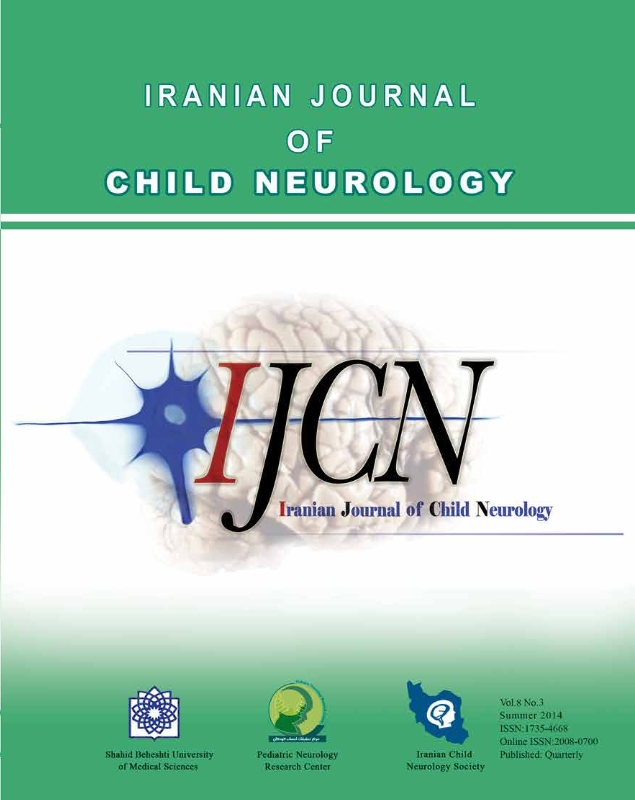How to Cite This Article: Karimzadeh P, Jafari N, Nejad Biglari H, Jabbeh Dari S, Ahmad Abadi F, Alaee MR, Nemati H, Saket S,
Tonekaboni SH, Taghdiri MM, Ghofrani M. GM2-Gangliosidosis (Sandhoff and Tay Sachs disease): Diagnosis and Neuroimaging Findings (An Iranian Pediatric Case Series) Iran J Child Neurol. 2014 Summer;8(3): 55-60.
Abstract
Objective
GM2-Gangliosidosis disease is a rare autosomal recessive genetic disorder that includes two disorders (Tay–Sachs and Sandhoff disease).These disorders cause a progressive deterioration of nerve cells and inherited deficiency in creating
hexosaminidases A, B, and AB.
Materials & Methods
Patients who were diagnosed withGM2-Gangliosidosis in the Neurology Department of Mofid Children’s Hospital in Tehran, Iran from October 2009 to February 2014were included in our study. The disorder was confirmed by neurometabolic and enzyme level detection of hexosaminidases A, B, and AB
in reference to Wagnester Laboratory in Germany. We assessed age, gender, past medical history, developmental status, clinical manifestations, and neuroimaging findings of 9 patients with Sandhoff disease and 9 with Tay Sachs disease.
Results
83% of our patients were the offspring of consanguineous marriages. All of them had a developmental disorder as a chief complaint.
38%of patients had a history of developmental delay or regression and 22% had
seizures. The patients with Sandhoff and Tay Sachs disease were followed for approximately 5 years and the follow-up showed all patients were bedridden or had expired due to refractory seizures, pneumonia aspiration, or swallowing
disorders.
Neuro-imaging findings included bilateral thalamic involvement, brain atrophy, and hypo myelination in near half of our patients (48%).
Conclusion
According to the results of this study, we suggest that cherry-red spots, hyperacusis, refractory seizures, and relative parents in children with developmental delay and/or regression should be considered for assessment of GM2-Gangliosidosis disease.
References
- Yun YM, Lee SN. A case refort of Sandhoff disease. Korean journal of ophthalmology: KJO. 2005;19(1):68-72. Epub 2005/06/03.
- O’Dowd BF, Klavins MH, Willard HF, Gravel R, Lowden JA, Mahuran DJ. Molecular heterogeneity in the infantile and juvenile forms of Sandhoff disease (O-variant GM2 gangliosidosis). The Journal of biological chemistry. 1986;261(27):12680-5. Epub 1986/09/25.
- Der Kaloustian VM, Khoury MJ, Hallal R, Idriss ZH, Deeb ME, Wakid NW, et al. Sandhoff disease: a prevalent form of infantile GM2 gangliosidosis in Lebanon. American journal of human genetics. 1981;33(1):85-9. Epub 1981/01/01.
- Cashman NR, Antel JP, Hancock LW, Dawson G, Horwitz AL, Johnson WG, et al. N-acetyl-beta-hexosaminidase beta locus defect and juvenile motor neuron disease: a case study. Annals of neurology. 1986;19(6):568-72. Epub 1986/06/01.
- Oonk JGW, Van der Helm HJ, Martin JJ. Spinocerebellar degeneration: hexosaminidase A and B deficiency in two adult sisters. Neurology 1979;29:380–384.
- Federico A, Ciacci G, D’Amore I, Pallini R, Palmeri S, Rossi A, et al. GM2 Gangliosidosis with Hexosaminidase A and B Defect: Report of a Family with Motor Neuron Disease-like Phenotype. In: Addison GM, Harkness RA, Isherwood DM, Pollitt RJ, editors. Practical Developments in Inherited Metabolic Disease: DNA Analysis, Phenylketonuria and Screening for Congenital Adrenal Hyperplasia: Springer Netherlands; 1986. p. 307-10.
- Gomez-Lira M, Sangalli A, Mottes M, Perusi C, Pignatti PF, Rizzuto N, et al. A common beta hexosaminidase gene mutation in adult Sandhoff disease patients. Human genetics. 1995;96(4):417-22. Epub 1995/10/01.
- Barbeau A, Plasse L, Cloutier T, Paris S, Roy M. Lysosomal enzymes in ataxia: discovery of two new cases of late onset hexosaminidase A and B deficiency (adult Sandhoff disease) in French Canadians. The Canadian journal of neurological sciences Le journal canadien des sciences neurologiques. 1984;11(4 Suppl):601-6. Epub 1984/11/01.
- Haghighi A, Masri A, Kornreich R, Desnick RJ. Tay- Sachs disease in an Arab family due to c.78G>A HEXA nonsense mutation encoding a p.W26X early truncation enzyme peptide. Molecular genetics and metabolism. 2011;104(4):700-2. Epub 2011/10/05.
- Tay SK, Low PS, Ong HT, Loke KY. Sandhoff disease- a case report of 3 siblings and a review of potential therapies. Annals of the Academy of Medicine, Singapore. 2000;29(4):514-7. Epub 2000/11/01.
- Ghosh M, Hunter WS, Wedge C. Corneal changes in Tay-Sachs disease. Canadian journal of ophthalmology Journal canadien d’ophtalmologie. 1990;25(4):190-2.Epub 1990/06/01.
- Hittmair K, Wimberger D, Bernert G, Mallek R, Schindler EG. MRI in a case of Sandhoff’s disease. Neuroradiology. 1996;38 Suppl 1:S178-80. Epub 1996/05/01.
- Koelfen W, Freund M, Jaschke W, Koenig S, Schultze C. GM-2 gangliosidosis (Sandhoff’s disease): two year follow-up by MRI. Neuroradiology. 1994;36(2):152-4.Epub 1994/01/01.
- Kokot W, Raczynska K, Krajka-Lauer J, Iwaszkiewicz- Bilikiewicz B, Wierzba J. [Sandhoff’s and Tay-Sachs disease--based on our own cases]. Klinika oczna. 2004;106(3 Suppl):534-6. Epub 2005/01/08. Choroba Sandhoffa oraz Tay Sachsa--w oparciu o przypadki wlasne.
- Barness LA, Henry K, Kling P, Laxova R, Kaback M, Gilbert-Barness E. A 7-year old white-male boy with progressive neurological deterioration. American journal of medical genetics. 1991;40(3):271-9. Epub 1991/09/01.
- Arisoy AE, Ozden S, Ciliv G, Ozalp I. Tay-Sachs disease: a case report. The Turkish journal of pediatrics. 1995;37(1):51-6. Epub 1995/01/01.
- Ozkara HA, Topcu M, Renda Y. Sandhoff disease in the Turkish population. Brain & development. 1997;19(7):469-72. Epub 1997/12/31.
